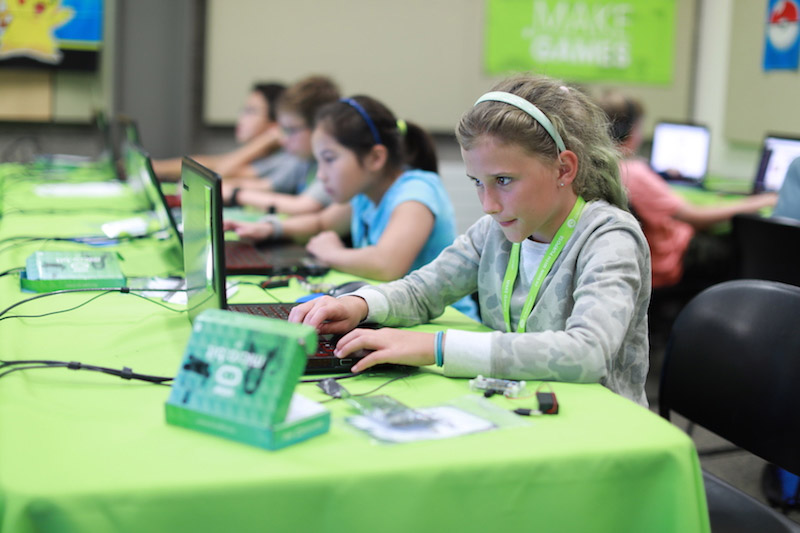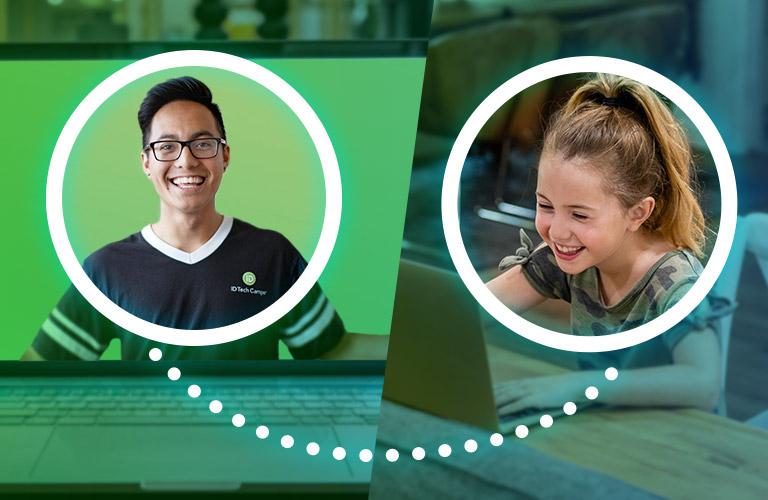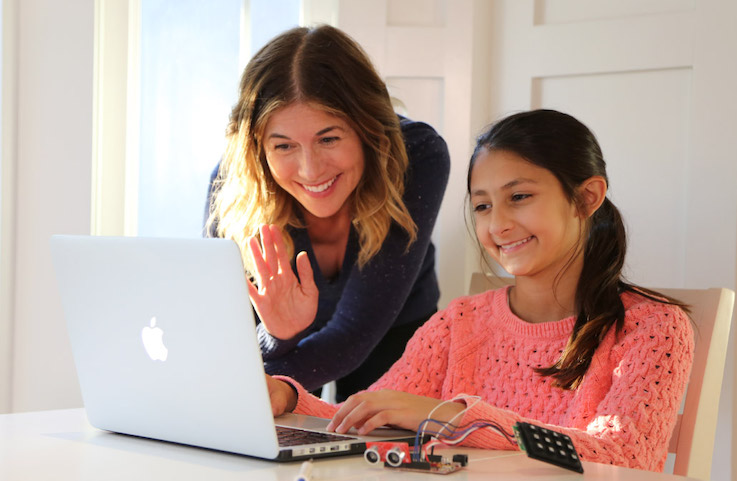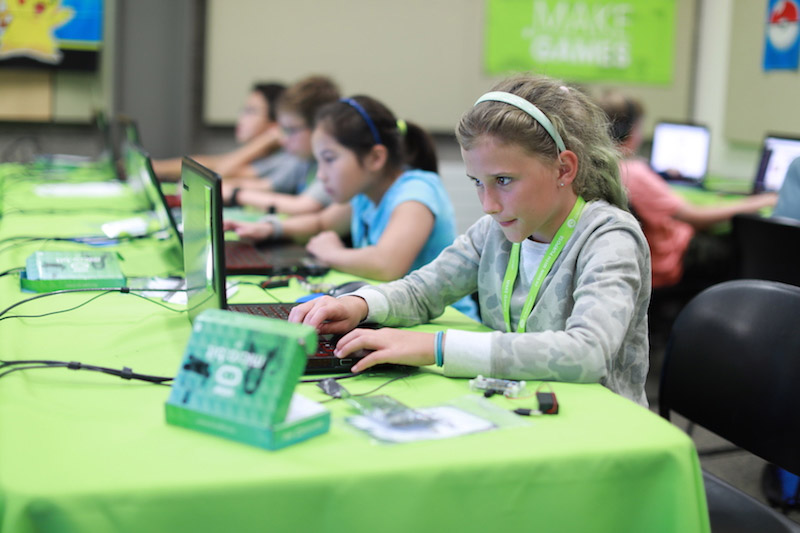Inspirational journeys
Follow the stories of academics and their research expeditions
Coding for kids: Reasons kids should start coding & how they can find success

Coding for kids seems like an impossible
journey, right? It’s a lot like learning an entirely new language (literally)!
Thus, simply asking children to picture themselves building
something like an app is a difficult enough task in itself.
We’ve all been there: a blank slate can be a very scary and overwhelming
roadblock, and can lead to a number of questions. “Is coding for me? How am
I ever going to get to a point where coding comes easy? When will I be able to
use these new coding skills to complete a finished project?”
Questions like these have stopped many in their tracks before they have
even given themselves the chance to begin.
It's understandable—first you have to plan, then you have to learn.
After that, you have to be good enough to create something. But before you can
even begin learning, you have to decide what it is you’re going to learn.
Not to mention that you need to have a great understanding that the
thing you’re learning is going to pay off in the end.
There is no way around it. It’s quite the challenge.
But think about it this way: any new task always seems impossible from
the start, and is in fact impossible if you don’t take all of the necessary
steps - and in the right order - beforehand.
This means that jumping in with two feet could actually lead to more
frustration, and even lessen the chance of follow through and eventual
success compared to starting small, taking your time, and achieving little
victories along the way.
So, let's start small.
WHAT
IS CODING FOR KIDS?
Coding for kids refers to the opportunities available for children
to get involved in coding. These opportunities aim to be fun and gamified to
keep kids' young minds engaged. You might also hear coding referred to as
"programming," or "computer programming."
And while it is difficult to imagine a child learning something so
complex, coding can be a reality for kids thanks to the many coding summer camps,
websites, coding tutors, after-school programs,
and toys.
Coding is not always the typical "computer science" that
you or your children might instinctively avoid.
In fact, coding is simply how we communicate with computers, and what we
use to build and run websites, apps, games, and more.
This communication is carried out via a number of different languages,
including:
- Scratch: A visual, drag-and-drop coding experience
- Python: Easy-to-read code that is great for
beginners
- Java: The language tested with the AP Computer
Science exam
- C++: Which is used to create software, code games,
and more
HOW
TO GET YOUR CHILD TO CODE?
Getting your child to code can take one of many paths.
So, let’s start by focusing on moving one direction—forward. It doesn’t
have to be a giant leap, and you don't have to be the one tasked with teaching
coding. In fact, per the above, it should really only be a small step for now,
and you can utilize a number of different resources to assist.
The important thing is that with each move, your child experiences
progress.
So, we are going to navigate this coding landscape through the various
topics:
- Why kids should learn coding
- Coding definitions
- Best coding languages
- Kid coder success stories
- How to realistically start a learning journey
- Coding resources
Ready?
IS
CODING GOOD FOR KIDS?
Time has passed since the idea of coding for kids started to really gain
traction, yet we are still seeing STEM education stats like
by 2025, 3.5 million STEM jobs will go unfilled.
And others like 71% of all new jobs in STEM are in computing, but only 8% of STEM graduates are in
Computer Science. People are still wondering if coding is hard to learn.
In other words, there are computer science jobs, lots of them—and
jobs that pay very well.
What makes this even better is that it’s not just the jobs (this would
be a much shorter blog post if that were the case). But also the creativity,
problem solving, collaboration, communication, and other skills ripe for
improvement as byproducts of kids learning to code.
So, kids should learn to code because:
- Coders are in high demand
- Coding provides a competitive advantage
- Coding knowledge allows students better understand
the world
- Coding is fun and satisfying
- Coding improves creativity
- Coding improves problem solving
- Coding improves persistence
- Coding improves collaboration
- Coding improves communication
WHY
IS CODING IMPORTANT? WHAT ARE THE BENEFITS?
Here is an explanation of the different reasons why coding is important.
1. Coders are in high demand
As mentioned, according
to Code.org, 67% of all new STEM jobs are in computing, yet only 11%
of STEM graduates are in Computer Science. That’s a serious shortage of CS
majors.
2. Coding provides a competitive advantage
when applying to colleges, internships, and jobs
If you possess a hot skill that many of your peers lack–such as the
ability to code–you instantly appear more desirable in the eyes of potential
college admissions officers and employers. Plain and simple.
3. With coding knowledge, students better
understand the world around them
Most of us don’t know the first thing about what makes our smartphones,
laptops, social media networks, and video games run. Basic programming
knowledge can change the way we interact with the technologies we use (and take
for granted) daily, and can open our eyes to the infinite possibilities of
coding.
4. Coding is fun and satisfying
While programming is logic-based, it’s also an extremely creative activity. If you have the skills, you can develop the aforementioned apps, code games, websites, and more! For many developers, part of the appeal of coding is the challenge and reward of seeing their code come to life after a good debugging session. Don’t be fooled, however–with the right instruction, getting started with programming can be easy and fun.
5. Coding improves creativity
When you learn a language, you use it to express yourself. The same is
true with code. Computer coding empowers kids to not only consume digital media
and technology, but to create it. Instead of simply playing a video game or
using an app, they can imagine making their own video game, or envision what
their own website, or app might look like—and they’ll have the outlet for
expression.
Thus, it's not always about the benefits directly related to computer
science. As the above has shown and below will show, there are plenty of
benefits that stem from getting involved with and taking an interest in
coding.
6. Coding improves problem solving
When kids code, they take complex problems and break them down into
smaller parts.
Kids learn what it’s like to approach a problem the way a software
engineer does, with logical, computational thinking.
As Dan Crow, CTO of SongKick explains,
“Computational thinking teaches you how to tackle large problems by breaking
them down into a sequence of smaller, more manageable problems.”
This logical thinking is a powerful tool in school, work, and life.
7. Coding improves persistence
Learning to code, like any new discipline, is a challenge. Thus,
tackling complex problems—and making mistakes along the way—can be very
frustrating.
Coding teaches the valuable skill of persistence in the face of such
challenges. Learning how to problem solve and look for solutions through
research and collaboration builds this highly desirable skill.
8. Coding improves collaboration
Every student can learn, and every student can learn how to code—kids
can learn alongside others of every race, gender, or background. Kids meet and
learn how to collaborate with all kinds of peers, all joined by a common
interest in technology.
Classrooms and other in-person environments, like iD Tech, bring kids together
for face-to-face collaboration. Kids learning online can also grow, asking each
other questions, and working to solve problems and create things together.
Many games, like Minecraft, also
offer a bevy of educational benefits because they too involve
coding, collaboration, and participation—with peers all over the world.
9. Coding improves communication
Communication is an absolutely essential skill throughout school, work,
and life. People who can clearly communicate complex ideas in simple terms tend
to be successful in different industries and walks of life.
When kids learn how to code, they learn how to communicate with the most
simple-minded audience imaginable: computers. As mentioned, computer coding
teaches kids how to break down complex ideas and arrange them in a way that
computers can understand.
But with all of that, proceed with caution…
At this point, you still might have a number of questions:
What if my child doesn’t want to learn to
code, specifically? Does that make them a failure?
Will they not have the chance to secure a
cool internship down the road? A worthwhile job?
What if they want to learn to just “tech”
instead? Is that a viable option?
What if they want to learn X? Or Y? Or Z?
Will those things count in the future?
Likewise, if they only learned to code, and
nothing else, would that take them to the top?
So, let me wrap up this section by saying me or whomever else urging you
to “learn to code” is probably not doing so with the intent of the statement to
be so exclusive.
I mean, you would never be encouraged to read, but not write. Or to
learn your multiplication tables while throwing division out the window.
Facebook was created by a programmer, but what would it be without design?
So, by all means, if you have a kid with a coding interest, then yes,
help them to LEARN. TO. CODE. If they don’t have an interest, have never coded,
and have other interests, still consider it, though. It’s that important, and
you’ll be glad you at least gave it a chance.
But in the process, don’t forget about the other things. Help them learn
to “tech,” and explore game development possibilities, 3D printing, or
video production if that's what better suits them. Immerse in photography if
that's truly what they want to do as a hobby or even a future career.
Have them get skilled in marketing, negotiation, promotion, and more… or
learn how to become a leader. There is a list of learning opportunities, and
that list goes on and on. Coding can take you far, but you must also possess
the complementary skills to make your creations thrive.
One of the most amazing things you’ll ever hear is that Steve Jobs didn’t code for Apple. Ever.
Can you believe that? If I asked you whether or not Steve Jobs was
successful, you’d turn around and ask me if the sky was blue or if grass was
green.
Jobs was one of the most successful people to roam the earth… not
because he was a supreme coder, but because he knew enough to communicate a
vision, and was wildly skilled elsewhere.
In the end, kids and teens who want to capitalize on the abundance of
computer science jobs in tomorrow’s landscape should be taking coding courses today.
Before all of that, let's take a look at some definitions.
WHAT ARE
SOME DEFINITIONS TO HELP UNDERSTANDING?
Learning a new language is difficult because without meaning, words are
just random combinations of letters.
Thus, it’s not enough to just be able to pronounce something—you need to
be able to understand what each and every word means in order to form a logical
statement.
So, let’s dive into a few of the major terms your kids and teens are
likely to encounter as they first embark upon their coding journey.
“Programming”
Does your son or daughter have a dog? Has your family tried to train
that dog?
The goal being, of course, is that you reach a point where you give a
command and the dog responds appropriately based on your instruction. “Sit.”
“Stay.” “Roll over.”
When it comes time for your kids to write a program, or program, they
are doing much of the same. They, as the “owner,” are communicating a set of
commands to a computer, with the expectation that the computer will respond
accordingly.
Of course, the difference here is that, instead of sternly vocalizing
those instructions with a liver-flavored treat hidden in their hand, kids will
be writing instructions in a programming language that kind of resembles familiar
English, but has a few additional parameters and rules.
Yes, training a dog is difficult, but take comfort in the fact that if
your child’s programming command is given correctly, the computer will always
listen. Success with a dog could hinder on the presence or absence of a nearby,
pesky squirrel.
Programming is the foundation of robotics, video games, apps, computer
graphics, and much more. And, every one of these programs is a set of
instructions; a sequence of short commands, one after another, with programming
used as the tool to write and disseminate those individual instructions.
“Programming language”
Based on the above, the crux of programming is the associated language.
In order to converse with a computer, you need to speak in terms it
understands.
First, think about the English language. We have words, but we also have
punctuation. There are also different rules and guidelines around when you
should use a particular form of a word, and when you should opt for another.
A programming language, then is made up of its own vocabulary and set of
rules—the difference is, each language is based on its own unique syntax
(grammatical structure) and semantics (meaning).
And yes, “each” language—as in there are multiple programming languages;
each with their own rules and use cases.
“Scratch programming”
We started by defining programming, and then talking about what a
programming language is.
While there are many, many other coding terms to define, it’s useful to
take a look at a term like Scratch programming, that represents a big piece of
what your child might encounter as they’re first getting started.
Scratch is a MIT-developed graphical programming language, based on
drag-and-drop programming basics so kids can easily create interactive stories,
comics, and more.
Scratch programming is popular for kids because instead of using lines
of code, youth users learn though colorful command coding blocks and
cartoon sprites. This means that without typing a single line of code, kids can
get their feet wet with programming statements and computational ideas, and
begin to test their limits of creative thinking in order to problem-solve.
Dive deeper: 12
coding definitions every kid (and parent) should know
WHICH CODING LANGUAGES ARE BEST?
Looking at everything that has been presented above, I hope you’re still
at a point of wanting to move forward!
Either way, this is a great place to stop and evaluate, because from
here on out we will be diving into the best coding language options for your
kids, while also taking a look at a few inspirational stories from kid coders
themselves.
Scratch and other visual programming
languages
See, I told you Scratch would be coming up again!
Since we already talked about it above, I won’t go into too much additional
detail, but really, visual programming is a great way to get a young,
inexperienced student into coding.
Sure, such platforms help teach coding but don't get into the
syntax necessary in most other coding languages, but that’s OK! This is all
about progress; moving forward, remember? Trying to put too much on to your
child’s plate typically does more harm than good.
With Scratch and other visual programming, it’s all about the simplicity
that gets kids excited about coding. The immediate gratification of dragging
and dropping commands and then seeing interactive stories, games, and
animations unfold is insanely powerful.
Dive deeper: Scratch
summer camp course for kids.
Additional resource: Scratch
game tutorial
Lua
While a little more involved and complex than a visual programming
option, Lua is still a great programming language for kids and teens who want
to pick up a language quickly.
And, I’ll pause here to state that half the battle of getting a child
engaged in something new (especially when that something comes with new
challenges) is connecting it to already-established interests.
So, do your kids like video games? Lua is a great for students
interested in applying their newfound coding skills to game programming. In
fact, the number of developers using Lua continues to rise, which translates
into job availability down the road. A student equipped with such skills can
jump into a variety of career options.
Plus, ever heard of Roblox? Top Lua developers who design games on
Roblox can make over $1 million a year! (Learn more
about Roblox
coding.)
Just to get a taste of what kids can expect, in our Lua
classes, students begin with Roblox's built-in editor to create 3D
worlds and expand their functionality with Lua. From there, they can create
scripts for their own game, or even sell scripts to other designers for use in
their games!
Dive deeper: Best
kids coding languages and best
coding classes for kids.
AT WHAT
AGE CAN KIDS REALLY LEARN CODING SKILLS?
Listen, if you’re feeling a little overwhelmed at this point, I don’t
blame you! It’s a lot of info on top of more info, and then some.
So, now is a good time to focus less on telling, and more on showing.
It might be near impossible to think of kids or even teens finding their
way…especially to a point where they’ll be equipped with coding skills to
perform in a lucrative career.
But like anything, it’s a process. Here at iD Tech, we call it the iD Tech
Pathway™, which by definition, is our long-term skill development system that
advances campers’ “love and mastery” of technology over time.
But in practice, it’s the idea that, just like learning a foreign
language or musical instrument, you’re going to have to dedicate more than one
hour of practice. Instead, to achieve “master” status, it’s best to start young
and continue to build passions and skills little by little.
Our STEM programs are set up to facilitate such a journey—kids can start
as young as 7 or 10-years-old with code lessons and courses in iD Tech Camps or Alexa Café, respectively,
and then continue their journey as teens with iD Coding & AI Academy, iD Game Dev Academy, or AcademyNEXT. At the end
of it all, they’re in perfect position to continue their pathway into college
and then eventually onward to an exciting career.
That said, we have seen students accomplish some incredible things. To
help you visualize what jumping into coding can do for your child, here are a
few of our favorite kid coder success stories.
Avi Schiffmann created a popular
COVID-19 and vaccine tracking website
Avi was seventeen years old when he created a website. And
not just any website, but rather one that was lauded as “one of the most vital
resources for people seeking accurate and updated numbers on the pandemic.”
Hundreds of millions of visitors later, the site stood out as a key info
source for those needing more info about the pandemic, including the number of
cases, and importantly, the number of people who had recovered, along with an
interactive map and real-time info.
While Avi’s story is amazing, we here at iD Tech have even a
deeper-rooted interest—Avi is a former iD Tech camper who attended one of our
coding programs, focusing on learning Python and more over three different camp
sessions. (Read more here.)
Matthew has worked at some of the most
prestigious companies in the world
While setting the goal to work at iconic companies like Dropbox,
Facebook, and Google could be considered lofty, it’s something Matthew wanted
to do for years. Once he set his mind to it, there was no stopping him!
Matthew says that his skill development started at iD Tech Camps and iD
Coding & AI Academy, summer
programs held at Stanford in the Silicon Valley. The experiences
taught him things he hadn’t learned in school, and gave him the opportunity to
work with industry-standard software.
He emphasizes the importance of working on projects outside of the
classroom. “It doesn’t matter what you develop, as long as it’s technically
challenging for you,” says Matthew. “This not only lets you build a strong
portfolio, but also provides a solid foundation for passionately answering
potential interview questions for your future career.”
And it brings up a great point, and another mark in the column of
"why bother?" It's because many school don't teach coding, meaning
computer science is still absent. Even when coding curriculum is present, it's
tough for students to be able to dive deep enough to make a truly impactful
difference.
Rebecca’s coding achievements were recognized
by the White House
This iD Tech alumna was recognized by the White House after founding
nonprofit CoderDojo NYC. Now, she's a Program Manager at Microsoft and a
powerful advocate for girls in STEM!
“My journey began as a 14-year-old girl at iD
Tech Camps in Cambridge, giving me an early chance to explore my
passions. Two weeks there changed my life; I was introduced to the idea of
technology as a fun and exciting career, and not some lofty idea for engineers
hiding in a lab,” Rebecca says.
A self-proclaimed “Jill of all trades,” Rebecca now works as a Program
Manager for Microsoft for Tech Jobs Academy, a 16-week technical training
program preparing talented New Yorkers for in-demand tech jobs in cloud and
server administration.
Dive deeper: Rebecca’s
story
Andrew’s apps have surpassed 50,000 downloads in the Apple App Store
This former iD Tech student found initial success selling his nine apps
in the Apple App Store. He has since shifted his focus to running his own
development companies and doing even more with his coding skills.
You would think that a list of accomplishments as long as Andrew’s would
have required years to compile—but this young developer was only in college
when he first started seeing success. With nine apps, 50,000 downloads, a class
that he developed and taught himself, and many other endeavors, it’s amazing
what this former student has achieved. Not to mention that he once thought of
programming as “intimidating.”
“Prior to attending iD Coding & AI Academy, I was intimidated by
iPhone programming. I had tried to teach myself, but gave up, thinking maybe I
wasn’t smart enough to program. Well, after two weeks, I was proven wrong—I
left with three completed or in-progress apps.”
HOW DO
YOU START TEACHING KIDS TO CODE?
With each of the above examples, success follows a clear process. Sure,
some of us are going to be more naturally gifted in certain areas than others,
but either way, we all must start at step one.
So, what is that step one when teaching kids to code,
or, to introduce kids to coding?
Well, to be honest, what follows isn’t for those who are sitting down at
the computer ready to program. There are online coding courses and
platforms for that, in person experiences, and more.
Rather, the words below are for those who are interested in learning
more; who hear about the importance of coding and want to wrap their minds
around what that might mean for their kids.
First, get your kids to start learning. Something. Anything! It doesn't
have to be a formal coding program. No tidbit is too small, and the basics like
the definitions mentioned above provide a great starting point,
Next, try and find someone for your child to talk to about what they've
learned. That could be you for now, or even a friend. As you can see, this step
doesn't require your child talk to someone knowledgeable about coding (but
it certainly can be).
From there, get your kids to do something. Again, small
is OK and actually encouraged here. It's best to keep realistic expectations.
So, it might only be an intro game or animation with Scratch, and again,
totally fine!
It's only after the points above should most kids set their sights on
something bigger. Bigger in terms of what they're learning, who they're talking
to, and of course, what they're doing.
The foundational tip through all of this is to try as much as you can to
connect the dots between already-established areas of familiarity and coding,
so that kids can readily see how different pieces of the world around us
fit together and are brought to life through coding.
ANYTHING
ELSE?
With all of this, is learning programming really as easy as “learning
something,” “talking to someone,” and “doing something” as stated above?
Of course not.
But, for those who have been stymied by just getting up and moving, a
set of guidelines so seemingly simple is a great place to get started.
Code is in fact the language of the future, and learning to code, while
great to know in itself, also strengthens creativity, problem solving, and a
host of other skills.
Thus, the value of learning to code isn't limited to the actual physical
act of coding, as it opens doors to a variety of related opportunities as well.
In less words, learning to code is hugely important, and hopefully this
guide helps you and your child take a step forward.
WHERE TO
GO NEXT
Many iD Tech students are eager to learn—not only because of their
interests in technology, but because many of them still aren’t receiving
valuable instruction in subjects like coding with their everyday schooling.
They leave their courses or code lessons with new skills, deeper knowledge, and
the confidence to go out and do something impactful with what they’ve learned.
We’ve seen this happen summer after summer.
Best of luck! See you next summer, online, or both!
CODING
RESOURCES
Online Learning
In-Person Coding Courses & Programs
- Coding Camps
- Coding Classes for Kids
- Scratch Programming Classes
- Java Coding with Minecraft
- Roblox Coding Classes
- LEGO Robotics Visual Coding
Coding Lessons
Coding Articles & Blogs
- Code.org
- Java for kids guide
- Web design (HTML) for kids
- Python 101 for Kids
- Minecraft coding guide
- Coding programs for kids
- C++ for kids
- Coding terms
- Coding for teens
- Improving your coding skills
- How to get coding experience
- Price of a coding class
- What are Minecraft mods?
- Is coding a good career?
- Algorithm examples for students
Coding Apps
Coding Toys
0 Comments
Categories
Recent posts
Ultimate guide to online tutoring services for kids & teens
Sun, 23 Jan 2022

Online courses
Sun, 23 Jan 2022




Leave a comment